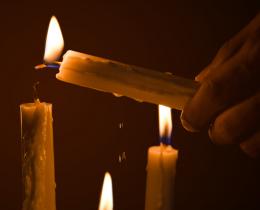“The motif of the return of the Great Goddess and her consort is encountered over and over again in the dreams and unconscious fantasies of people who seek psychological help to overcome the deadness of their lives. Arts, films, literature, and political upheavals also reflect increasingly the same dynamics. The changes they demand entail new understanding of masculinity and femininity in both men and women and the relations between the sexes as well as new views of reality.” —Edward C. Whitmont
When psychology and spirituality are used in tandem on the spiritual path, sooner or later we are called into the puzzling and productive territory of gender. As we use psychological wisdom to peel away the myths and illusions that have misinformed us, we inevitably confront our place in the world as a man or a woman. So many of our misconstrued notions about our selves are rooted in gender. It helps to explore this territory if we want to uncover our essential, spiritual nature.
It wasn’t clear to me when I first set out on the spiritual path how my natural affinity for feminism could be compatible with my interest in spirituality. In fact, it seemed that the basic foundations of most traditional spiritual paths were in direct conflict with the women’s movement that I had been a part of in college. When I became a formal student of a spiritual teacher in the 1970s, I moved down a few rungs on the evolutionary ladder, as far as I was concerned as a woman. The leadership of my teacher's organization was mostly male, the gender of the prayers was masculine, some of the traditional practices were segregated, and the subtle and not-so-subtle messages about daily life elevated the male perspective and negated women’s ways of seeing the world. Even though the type of spiritual organization I joined was influenced by the “liberated” sixties, the experience remained for me vastly similar to the experiences women always have within the patriarchal systems of religious institutions.
I use the word patriarchal with hesitancy. Its common usage implies a black and white situation where brutal men rule the world and innocent women suffer the consequences. I am more comfortable with another kind of definition: “By patriarchy,” writes the Jungian scholar Marion Woodman, “I mean a culture whose driving force is power. Individuals within that culture are driven to seek control over others and themselves in an inhuman desire for perfection.”
I often turn to Jungian psychology to better understand issues of gender. Jung separated personalities not so much into male and female, but into unique blends of masculine and feminine qualities, which he believed were found in all human psyches in varying degrees of potency. The masculine principle, or archetype, as Jung called it, celebrates rational thinking, heroic power, goal-oriented achievement, and independence. It is transcendent, visionary, mindful. The feminine principle loves to feel; it compels us to nurture; it links sexuality with relationship; and it reveres life and death as natural cycles of nature. It is embodied, intuitive, heartful.
The feminine is that part of the self that is vulnerable, receptive, open; the part that values connection and communication. It likes to put all the cards on the table and doesn’t want to hold back or keep secrets. It is the part that is comfortable right here on earth with all of its pain and messiness; the part that does not want to run away from life or try to change nature’s rules. This is the feminine archetype. The masculine archetype sees beyond this life, looks outside of itself, identifies with the eternal, and wants to move ever forward. It plans and negotiates, is reasonable and rational. It is on a mission to achieve, invent, build, make a mark. It is the part of the self that is determined, loyal, judicious, and steady.
A great pair, the feminine and the masculine. A person who cultivates his or her masculine and feminine qualities is able to balance power with love, inventiveness with sustainability, brilliance with wisdom. Of course, most of us are not naturally balanced within ourselves. We usually have more of one archetype than the other and it usually is true that women are much more heavily endowed with the feminine principle and men with the masculine principle. The point of working to balance our masculine and feminine energies is not to move toward androgyny. It is to become aware of the inner forces at play within each one of us and within the culture. Even as we strive for inner and outer balance, we still can depend on each other to fill in the missing pieces. In fact, the more we value both archetypes, the less pulled each one of us will feel to be “perfect,” and the less likely we will be to misunderstand the basic nature of our counterparts. We will be able to stand in for each other as we all grow toward wholeness.
Most of recorded human history is the story of one archetype—the masculine—not merely dominating, but also discounting the values of, the other—the feminine. It’s particularly ironic to note the suppression of the feminine in religious history, given that the basis for most religions is God’s all-embracing inclusion and love of all creation. As the poet Jane Hirshfield says about God’s egalitarian spirit, “the numinous does not discriminate...infinitude and oneness do not exclude anyone.” But indeed, the feminine voice has been excluded in most religious traditions to the point where spiritual myths, images, and structures are primarily masculine. Even more harmful than their mere exclusion, feminine values have also been deemed inferior, even dangerous, in patriarchal cultures. Backed up by our earliest religious myths, from Adam and Eve to Prometheus and Pandora, the message has been insidiously clear: feminine values are manipulative and untrustworthy, bound by the suffering of the earth, controlled by the dark side of the moon, and more related to the animals than to the angels.
It is the masculine principle within humans that is attracted to transcendent spirituality—always moving forward, intent on self-improvement, compelled by the light of truth beyond the horizon. The feminine principle is more at home with the way things already are. Feminine energy moves in a circle, longing to know all by embracing all. In valuing one archetype and rejecting the other, as opposed to enjoying the fruits of the marriage of both, we have denied many people, not just women, their natural way of finding God.
Religions have perpetrated the myth of masculine superiority as much as any social system has; in fact, I think that until we rewrite our spiritual mythology, societal structures will continue to empower men and mistrust women. The first step of the women’s movement has been the demanding of equal status for women within the patriarchy. This has been a critically important step. But it has also masked other, equally important steps: the celebration of feminine values in the world; the granting of respect, money, and power to the kind of work that nurtures families, teaches the young, connects communities, and cares for the earth; and the acceptance that while men’s and women’s wisdom may be different, each is real, precious, and necessary.
It’s not enough to say that spirituality transcends gender, even if it ultimately does. Spirituality is the human search for eternal wisdom. It is not the wisdom itself. To humanize spirituality, we must not only look outside of ourselves to the limitless universe, but also inside of our own personhood—the sum total of our gender, our conditioning, our genes, and our unique challenges and gifts. Obviously then, different people will respond better to different spiritual concepts and techniques. Some people will use their minds most effectively. Others will find it easier to search for God using the physical body or the emotions. Some people, when they think of the ultimate truth, use language and images of light and glory. Others relate to the stark aloofness of the ascetic’s search. Still others discover truth right here on earth, inspired by the interconnection of all life and through service to others.
Both genders are capable of tapping into the masculine and feminine wisdom streams. But first, we must question the patriarchal obsession with power and control in the culture, and widen the definition of reality to include the feminine principle. To some extent, this has been the role of feminism in our times. When feminism and spirituality combine forces, the feminine face of God will illuminate the path for all of us.



